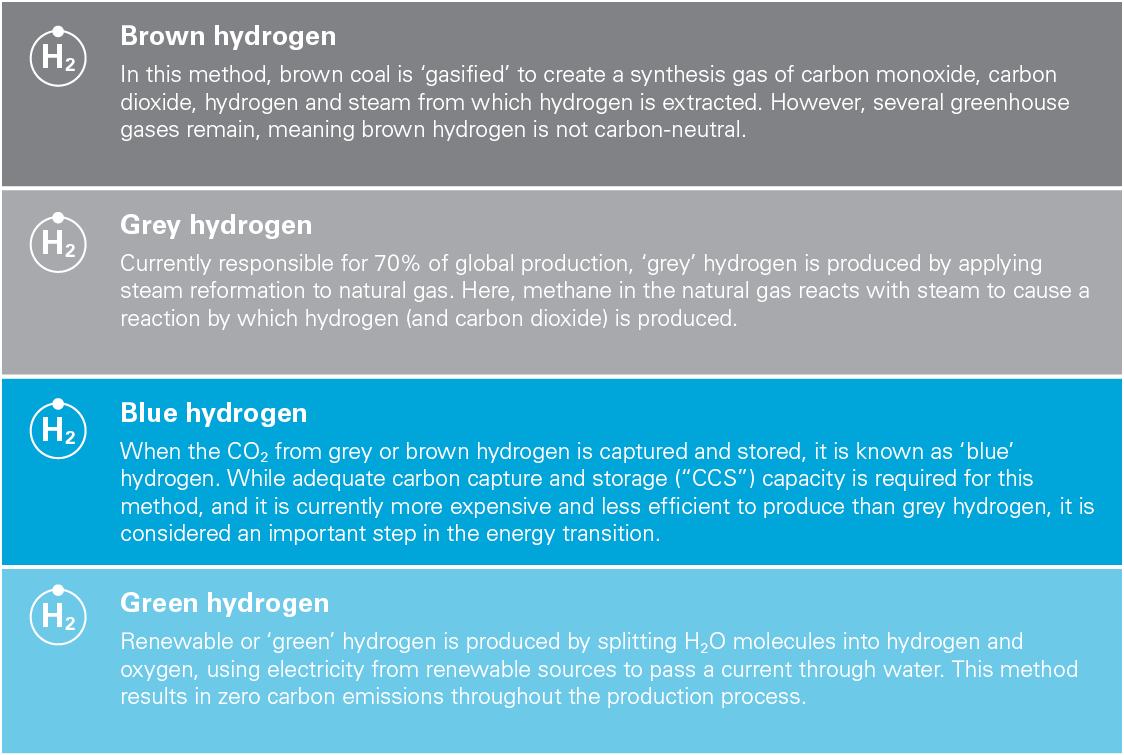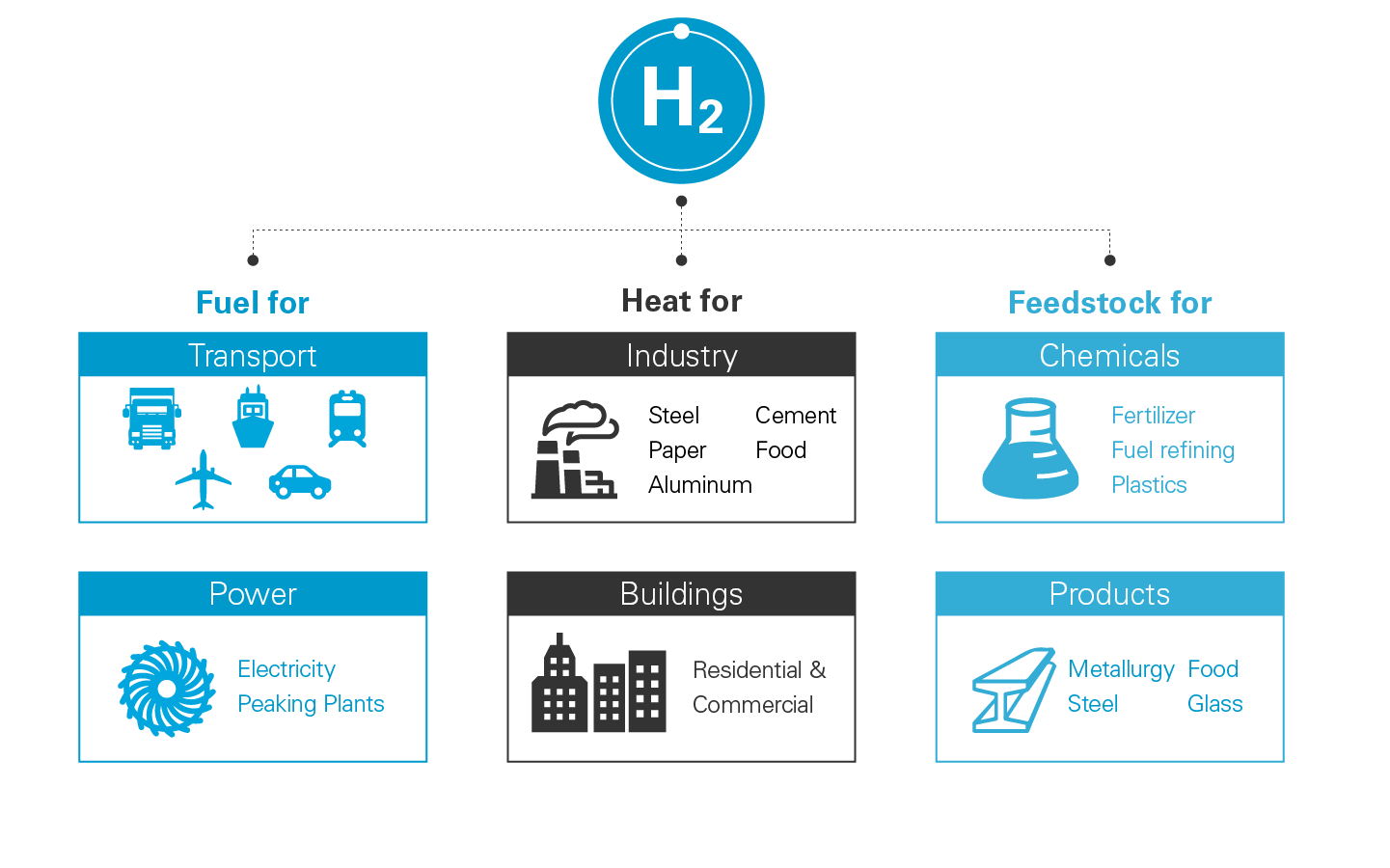
As hype builds around the transformative role hydrogen could play in the clean energy transition, we examine the unique opportunities open to market players in Asia-Pacific. This is the first in a series of three articles on the hydrogen economy. Part 2 of the series is now available.
Hydrogen Economy Series: Part 1
Hydrogen is the most abundant chemical substance in the known universe. Extracting its true value, however, has proven elusive. In order to use it as a fuel, heat source or feedstock, hydrogen usually needs to be produced using a chemical reaction. Hydrogen's molecular properties mean it can be used in a variety of industry sectors. Crucially, it produces zero carbon emissions when burned, which has led some commentators to label it the ‘silver bullet' the world needs to fight the effects of climate change.
White & Case is recognised as a leader in the energy space, including renewables and liquefied natural gas (LNG). We have advised sponsors, lenders and governments on many transformative projects in the Asia-Pacific region.
As part of our recent Back to Business series, our Tokyo office led a webinar on hydrogen's role in the regional energy transition, which brought together a group of market-leading experts for a thought-provoking discussion. In this three-part series, we identify the core pillars of the growing ‘hydrogen economy', and analyse the key global trends driving change in the rapidly evolving hydrogen landscape.
Background
Touted as the clean molecule the world needs to secure a sustainable energy future, hydrogen is clean-burning, may be produced from renewable sources of power and has a variety of applications in multiple industry sectors.
Hydrogen is not a raw fuel and must be produced using a chemical reaction. The most established methods are colour-coded as follows:
Versions of the ideal hydrogen economy vary, but all feature the use of green hydrogen as a substitute for fossil fuels. This could be particularly promising in hard-to-abate industrial sectors such as steelmaking and heavy transport, as these processes require molecules with high energy densities (and have therefore been historically dominated by fossil fuels). Energy-dense green hydrogen, however, could step into this role without the undesirable side effects.
The Hydrogen Economy
Hydrogen's potential applications in fossil fuel-intensive industries have created considerable hype around the role it could play in reducing and perhaps eliminating carbon emissions. This is especially the case if a hydrogen market can be scaled up effectively and on a global scale, to create a 'hydrogen economy'.
The clean energy transition is generally described as the shift being made by the global energy industry away from fossil fuel-based production towards renewable or clean energy resources. This movement is driven by combination of factors including the effects of climate change, governmental policies and changes in consumer and investor attitudes.
"Green hydrogen could be particularly promising in hard-to-abate industrial sectors such as steelmaking and heavy transport, as these processes require molecules with high energy densities."
Despite a growing hype around hydrogen, the concept of a hydrogen economy is not a new one. Hydrogen's potential applications have been well-known for decades: it was promoted as a mass replacement for hydrocarbons such as oil and gas as early as the 1970s following the oil crisis, and repeatedly since the 1990s as awareness of climate change has grown.
Hydrogen has three primary uses: fuel, heat and as a feedstock.
Source: BloombergNEF
If hydrogen is to play a major role in the clean energy transition, its most attractive uses are in sectors for which abatement has proven difficult: industrial manufacturing, heavy transport and power generation.
Industrial manufacturing
Industrial processes such as steelmaking, cement production and ammonia synthesis are predominantly powered by fossil fuels such as coal and natural gas, due to the high energy density usually found in these fuels. Where hydrogen's potential is unlocked by lower production costs and enhanced by, for example, a price on carbon emissions, it can be used as a substitute due to its properties as a molecular fuel.
Heavy transport and fuel cells
Fuel cell technology is a fast-growing alternative to battery-powered electric vehicles. While batteries store and release electricity to provide power, fuel cells rely on a chemical reaction between hydrogen and water to create an electrical current that powers vehicles. The only by-product of this process is water, or steam (H2O).
Hydrogen-powered fuel cells may be more economically feasible for heavy transport than passenger vehicles. Battery-powered electric cars currently dominate fuel cells in the passenger vehicle market, but hydrogen's higher energy density means fuel cells have a power density that is greater than lithium-ion batteries. This is conducive to long-distance transport because the range of a fuel cell vehicle can be easily increased by simply adding more hydrogen tanks to the same fuel cell stack (given sufficient space), giving fuel cells a marginal cost advantage over batteries.
Power generation
Hydrogen's potential applications in power generation are twofold:
- first, green hydrogen may be used as a feedstock for hydrogen-fired turbine power stations, which would generate clean and dispatchable power; and
- second, when combined with large-scale geological storage and renewable energy facilities, green hydrogen could be produced from excess renewable electricity. It could then be stored, potentially used in grid stabilisation or transported for use as a feedstock in the first-mentioned process.
If both these applications are embraced, a zero-carbon electricity network could be powered by a hydrogen supply chain. If effective transportation and storage infrastructure could be developed, it would be a particularly attractive proposition for renewable energy assets in remote locations. This would require significant up-front investment and a vastly lower cost base, however.
Leading the Transition
A fully formed and functioning hydrogen economy is still some way off. Notwithstanding today's nascent green hydrogen production market, the International Energy Agency estimates the number of electrolyser projects and installed capacity has increased from less than 1 MW in 2010 to more than 25 MW in 2019. Importantly, renewable energy prices and the cost of electrolysers have also fallen over that period.
Stakeholders in the gas industry advocate for a staged approach to developing the hydrogen economy, beginning with developing CCS to enable blue hydrogen production. Resources companies believe there are significant synergies with hydrogen to be explored before a full transition to green hydrogen, given their reserves of gas, evolving CCS and CCUS (carbon capture, utilization and storage) capabilities, and opportunities to repurpose existing technology and facilities to accommodate blue hydrogen.
Due to the significant costs involved in sufficiently scaling up hydrogen infrastructure, governments have an important role to play in supporting industry investment and creating a regulatory framework that can support hydrogen project development.
The early signs are promising: South Korea and Japan have made hydrogen a cornerstone of their long-term energy strategies and have made well-publicised calls for an overseas hydrogen production base which can service its import demands. Germany recently announced a €130 billion pandemic recovery budget dominated by green initiatives, including a fully-funded target of 5GW of electrolysers by 2030. Australia, richly endowed with natural and renewable resources, is well-placed to become a hydrogen export powerhouse in the long term.
The move to a hydrogen economy is likely to involve synergies between the renewable energy industries and gas industries, and projects involving an international group of sponsors, lenders, and offtakers. To come to fruition, any version of the hydrogen economy must take advantage of the increasing international connectivity across energy markets. In Part 2 of this Series, we examine the hydrogen market today and what it means for market participants, including the key challenges and opportunities.
Click here to download the PDF of the Hydrogen's New Dawn.
This publication is provided for your convenience and does not constitute legal advice. This publication is protected by copyright.
© 2020 White & Case LLP



